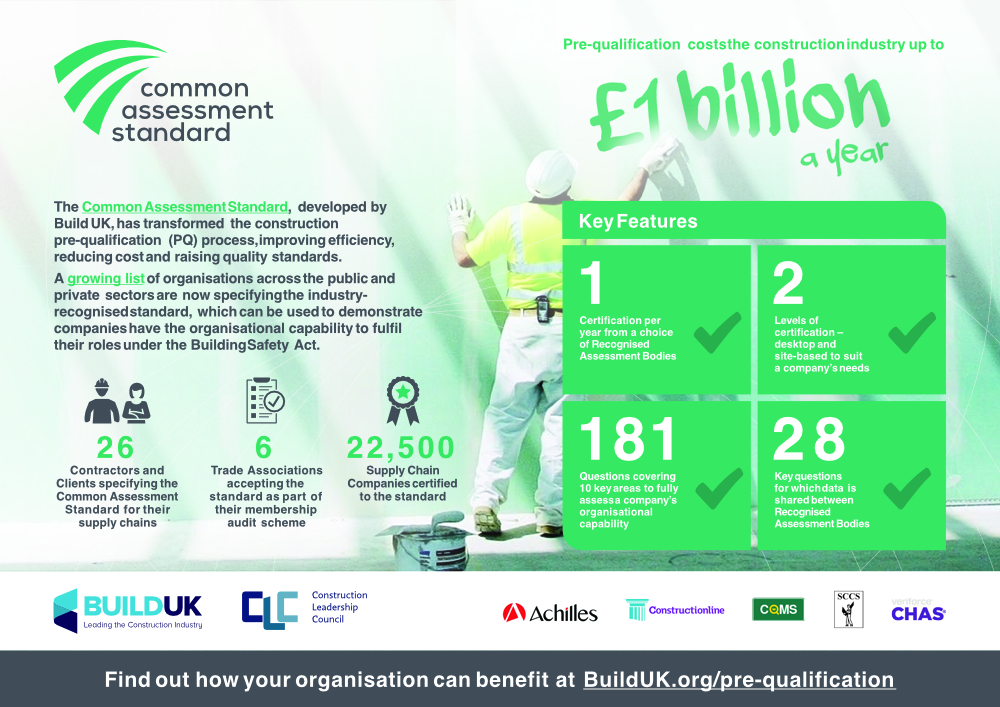The common assessment standard
[edit] About the common assessment standard
The Common Assessment Standard is an industry-agreed set of questions and corresponding assessment standards for the pre-qualification of suppliers. There are two levels of certification: desktop and site-based, which build on the PAS 91 pre-qualification questionnaire, helping contractors achieve compliance and mitigate risks across essentially 13 key areas of risk management. Evidence of compliance in these areas is normally required once a year via an online portal.
The Common Assessment Standard, was developed by Build UK, the Civil Engineering Contractors Association (CECA) and other accreditation bodies and industry experts, it is regularly reviewed. It was launched initially in 2019, at which time CHAS became the first assessment body to offer the scheme. In 2021 the introduction of a data-sharing agreement accelerated its adoption, meaning the details of those who pass the assessment can be accessed via any of the providers, regardless of which assessment body carries out the audit. On July 1, 2024 Version 4 of the Common Assessment Standard was published, including a new Building Safety section, ensuring it can be used to demonstrate companies have the organisational capability to fulfil their roles under the Building Safety Act.
Below is a lists of the contents of Version 4 of the Common Assessment Standard issued in 2024 (with the previous headings from the 2023 version in brackets both the new and old versions cover 10 key areas;
- Section 1: Identity
- Section 2: Financial
- Section 3: Corporate and Professional Standing
- Section 4: Health and Safety
- Section 5: Environmental
- Section 6: Quality
- Section 7: Building Safety (previously Equality)
- Section 8: Fairness, Inclusion and Respect - FIR (previously Corporate Social Responsibility- CSR)
- Section 9: Information Security (previously Information Security and GDPR)
- Section 10: Information Management (IM)
The Common Assessment Standard is now a leading accreditation programme that is recognised industry-wide and is designed to improve efficiency and reduce cost in the construction pre-qualification (PQ) process. As an accreditation system designed to standardise the pre-qualification process, it helps both clients and contractors improve supply chain efficiency, reduce supply chain risks, and find reliable business opportunities. Clients can access a database of qualified contractors via the services of the assessment bodies.
In 2022, 16,000 supply chain companies were certified to the scheme, with 22 contractors and clients specifying it as a requirement and 4 trade association requiring it as a standard. Now in 2024 22,500 supply chain companies are certified with the scheme, 26 contractors and clients specifying it and 6 trade associations requiring it as a standard. Within the public sector, the Crown Commercial Service (CCS) has for some time asked contractors appointed to seven-year frameworks to assess their supply chains using the Common Assessment Standard. However in 2023 the Procurement Policy Note (PPN) 08/16 advising of this, was changed with PPN 03/23 requiring the use of the CAS or PAS 91 for substantial construction and other public works. In 2024 it is recommended that Central Government departments and wider public sector bodies should use the Common Assessment Standard to pre-qualify suppliers in accordance with PPN 03/24.
There are two levels of certification: desktop and site-based. Companies apply to a Recognised Assessment Body for the certification level that is most appropriate for their business based on a range of factors including trade, size and the requirements of their clients. For companies that employ fewer than 10 employees and have a turnover below £1.8 million or a balance sheet total less than £1.8 million, the assessment standards are applied in a proportionate way. A guide to the question set has been published to help companies prepare for an audit by a Recognised Assessment Body.
[edit] Related articles on Designing Buildings
- Appointing consultants.
- Common minimum standards.
- Constructionline.
- Construction contract.
- Government construction strategy.
- Invitation to tender.
- PAS 91.
- Pre-qualification standard 2021.
- Pre tender interview.
- Procurement route.
- Procurement policy note PPN.
- Public sector PQQs look to the Common Assessment Standard.
- Selection criteria.
- Tender.
[edit] External links
- For further information https://builduk.org/priorities/increasing-productivity/pre-qualification/
- Infographic https://builduk.org/wp-content/uploads/2022/04/Common-Assessment-Standard-Infographic.pdf
- The set of CAS questions can be viewed here; https://builduk.org/wp-content/uploads/2022/06/Common-Assessment-Standard-Question-Set-Version-3.1.pdf
Featured articles and news
Moisture, fire safety and emerging trends in living walls
How wet is your wall?
Current policy explained and newly published consultation by the UK and Welsh Governments.
British architecture 1919–39. Book review.
Conservation of listed prefabs in Moseley.
Energy industry calls for urgent reform.
Heritage staff wellbeing at work survey.
A five minute introduction.
50th Golden anniversary ECA Edmundson apprentice award
Showcasing the very best electrotechnical and engineering services for half a century.
Welsh government consults on HRBs and reg changes
Seeking feedback on a new regulatory regime and a broad range of issues.
CIOB Client Guide (2nd edition) March 2025
Free download covering statutory dutyholder roles under the Building Safety Act and much more.
AI and automation in 3D modelling and spatial design
Can almost half of design development tasks be automated?
Minister quizzed, as responsibility transfers to MHCLG and BSR publishes new building control guidance.
UK environmental regulations reform 2025
Amid wider new approaches to ensure regulators and regulation support growth.
The maintenance challenge of tenements.
BSRIA Statutory Compliance Inspection Checklist
BG80/2025 now significantly updated to include requirements related to important changes in legislation.
Shortlist for the 2025 Roofscape Design Awards
Talent and innovation showcase announcement from the trussed rafter industry.

























Comments
[edit] o make a comment about this article, click 'Add a comment' above. Separate your comments from any existing comments by inserting a horizontal line.